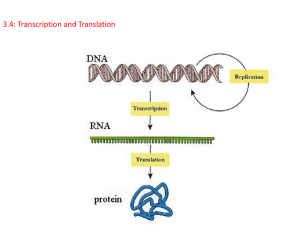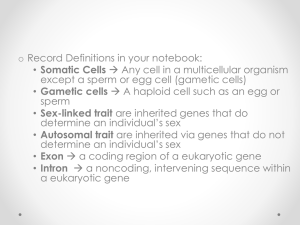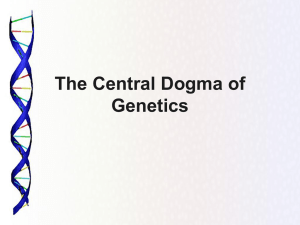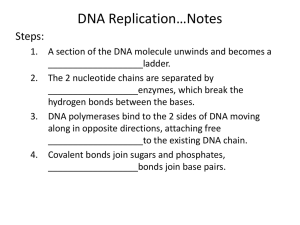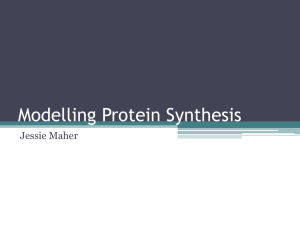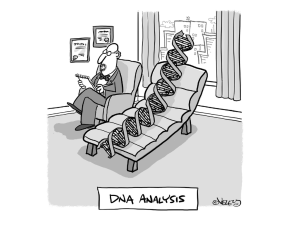Review Sheet : DNA, RNA & Protein Synthesis
advertisement
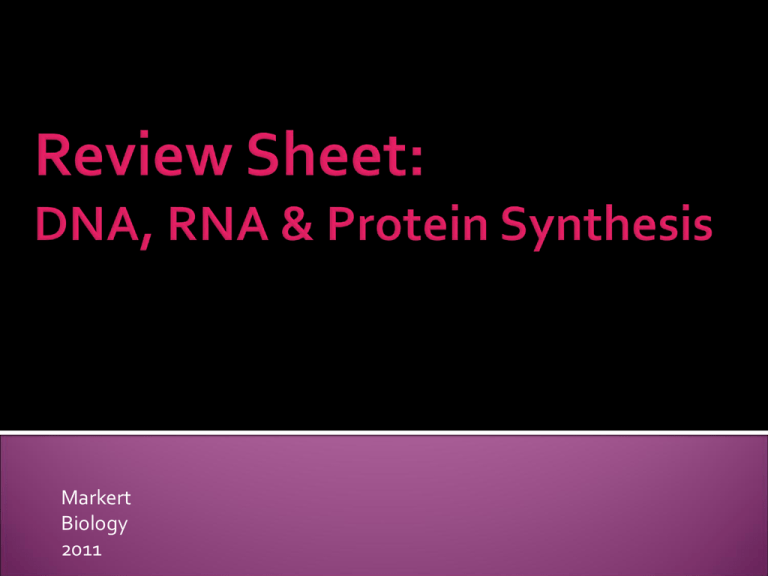
Markert Biology 2011 Molecules of DNA are composed of long chains of _______ Nucleotides A nucleotide consists of _______, _________, and __________. a sugar, a phosphate group, and a nitrogen base. The part of the molecule for which deoxyribonucleic acid is named is the _______ sugar - deoxyribose Of the four nitrogen bases in DNA, which two are purines and which two are pyrimidines? Purines are Adenine and Guanine Pyrimidines are Thymine and Cytosine Which of the following is not true about DNA replication? a. It must occur before a cell can divide b. Two complementary strands are duplicated. c. The double strand unwinds and unzips while it is being duplicated. d. The process is catalyzed by enzymes called DNA mutagens. d. The process is catalyzed by enzymes called DNA mutagens. RNA differs from DNA in that RNA a. _______ b. _______ c. _______ is single-stranded. contains the nitrogen base uracil. contains a different sugar molecule. In RNA molecules, adenine is complementary to _______ uracil The function of rRNA is to form _______ ribosomes During transcription, the genetic information for making a protein is “rewritten” as a molecule of _______ messenger RNA Each nucleotide triplet in mRNA that specifies a particular amino acid is called a(n) _______ codon Each of the following is a type of RNA except a. b. c. d. carrier RNA. messenger RNA. ribosomal RNA. transfer RNA. a. carrier RNA. A ribosome has A. one binding site for DNA. B. three binding sites used during translation. C. four binding sites for tRNA. D. no binding sites since the proteins must detach. B. three binding sites used during translation. NOT ON THE TEST!!! The form of ribonucleic acid that carries genetic information from the DNA to the ribosomes is _______ mRNA mRNA codons amino acid UAU, UAC tyrosine CCU, CCC, CCA, proline CCG GAU, GAC aspartic acid AUU, AUC, AUA UGU, UGC isoleucine cysteine Refer to the illustration. Suppose that you are given a protein containing the following sequence of amino acids: tyrosine, proline, aspartic acid, isoleucine, and cysteine. Use the portion of the genetic code given to determine which of the following contains a DNA sequence that codes for this amino acid sequence. a. AUGGGUCUAUAUACG b. ATGGGTCTATATACG c. GCAAACTCGCGCGTA d. ATAGGGCTTTAAACA b. ATGGGTCTATATACG Transfer RNA a. carries an amino acid to its correct codon. b. synthesizes amino acids as they are needed. c. produces codons to match the correct anticodons. d. converts DNA into mRNA. a. carries an amino acid to its correct codon. amino acid attachment site UA C anticodon Transcription is the process by which genetic information encoded in DNA is transferred to a(n) _______ RNA molecule A DNA subunit composed of a phosphate group, a fivecarbon sugar, and a nitrogen-containing base is called a(n) _______ nucleotide The name of the five-carbon sugar that makes up a part of the backbone of molecules of DNA is _______ deoxyribose Watson and Crick determined that DNA molecules have the shape of a(n) _______ double helix Due to the strict pairing of nitrogen bases in DNA molecules, the two strands are said to be _________to each other. complementary The process by which DNA copies itself is called _______ replication The nitrogen-containing base that is only found in RNA is _______ uracil Messenger RNA is produced during the process of _____ transcription During translation, amino acids are brought to the ribosomes by molecules of _______ transfer RNA amino acid attachment site UAC anticodon Nucleotide sequences of tRNA that are complementary to codons on mRNA are called _______ anticodons The sequence of three nucleotides that code for specific amino acids or stop signals in the synthesis of protein is called a(n) _______ codon The information contained in a molecule of messenger RNA is used to make protein during the process of _____ translation Use the base pairing rules to correctly match the nitrogen bases together. _____ pairs with ______ ______ pairs with _________ •Use the base pairing rules to correctly match the nitrogen bases together. ________________pairs with_______________ ________________pairs with ______________ Use the base pairing rules to correctly match the nitrogen bases together. T A _________ pairs with ______ G pairs with _________ C ______ For each process below, identify where it occurs in the cell and what is produced. Replication: Transcription: Translation •Use the base pairing rules to correctly match the nitrogen bases together. ________________pairs with_______________ ________________pairs with ______________ For each process below, identify where it occurs in the cell and what is produced. Replication: Nucleus, identical DNA strand Transcription: Nucleus, mRNA Translation Ribosomes, tRNA - protein List three differences between DNA and RNA a. b. c. •Use the base pairing rules to correctly match the nitrogen bases together. ________________pairs with_______________ ________________pairs with ______________ List three differences between DNA and RNA a. DNA – double strand; RNA – single strand b. DNA – deoxyribose sugar; RNA – ribose sugar c. DNA – Thymine nitrogen base; RNA – Uracil nitrogen base Identify 3 types of RNA, where they are found and what they do. a. b. c. •Use the base pairing rules to correctly match the nitrogen bases together. ________________pairs with_______________ ________________pairs with ______________ Identify 3 types of RNA, where they are found and what they do. a. mRNA – b. tRNA – c. rRNA - •Use your codon chart on to complete the table below. Use your codon chart on to complete the table below. DNA Triplet TTC mRNA codon UAG tRNA anti-codon Amino acid coded CAG met •Use the base pairing rules to correctly match the nitrogen bases together. ________________pairs with_______________ ________________pairs with ______________ DNA Triplet TTC TAC mRNA codon tRNA anti-codon Amino acid coded ATC CAG UAG AUG UAC met GUC AAG CAG VAL UUC AUC LYS STOP Using the following DNA sequences, identify each of the following: Mutations: substitution, insertion and deletion TAC GCC AGC CCG AGC TAT AAA ATT Mutation: ___________________________ 1: TAC GCA GCC CGA GCT ATA AAA TT Mutation ___________________________ 2: TAC GCC AGC CCG AAC TAT AAA ATT Mutation ___________________________ 3: TAC GCC ATG CCC GAG CTA TAA AAT T •Use the base pairing rules to correctly match the nitrogen bases together. ________________pairs with_______________ ________________pairs with ______________ Mutations: substitution, insertion and deletion TAC GCC AGC CCG AGC TAT AAA ATT DELETION Mutation: ___________________________ 1: TAC GCA GCC CGA GCT ATA AAA TT SUBSTITUTION Mutation ___________________________ 2: TAC GCC AGC CCG AAC TAT AAA ATT INSERTION Mutation ___________________________ 3: TAC GCC ATG CCC GAG CTA TAA AAT T Which mutations above would have the have the greatest impact on an organism? Why? •Use the base pairing rules to correctly match the nitrogen bases together. ________________pairs with_______________ ________________pairs with ______________ Which mutations above would have the have the greatest impact on an organism? Why? ????????? C E D, F G F D H



